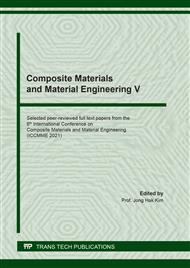[1]
Wagner, H. (1932). Über Stoß‐ und Gleitvorgänge an der Oberfläche von Flüssigkeiten. ZAMM ‐ Journal of Applied Mathematics and Mechanics/Zeitschrift Für Angewandte Mathematik Und Mechanik, 12(4), 193–215. https://doi.org/10.1002/zamm.19320120402.
DOI: 10.1002/zamm.19320120402
Google Scholar
[2]
Qin, Z., & Batra, R. C. (2009). Local slamming impact of sandwich composite hulls. International Journal of Solids and Structures, 46(10), 2011–2035. https://doi.org/10.1016/j.ijsolstr.2008.04.019.
DOI: 10.1016/j.ijsolstr.2008.04.019
Google Scholar
[3]
Hayman, B. (2010). Response of Sandwich Structures to Slamming and Impact Loads. Composite Materials in Maritime Structures, 161–177. https://doi.org/10.1017/cbo9780511751844.010.
DOI: 10.1017/cbo9780511751844.010
Google Scholar
[4]
Chen, J. K., & Sun, C. T. (1985). Dynamic large deflection response of composite laminates subjected to impact. Composite Structures, 4(1), 59–73. https://doi.org/10.1016/0263-8223 (85)90020-0.
DOI: 10.1016/0263-8223(85)90020-0
Google Scholar
[5]
Tamayo-Meza, P., Ovchinsky, A. S., Sandoval-Pineda, J. M., Flores-Herrera, L. A., & González Huerta, R. de G. (2014). Estudio de la dinámica de los procesos de fractura y de delaminación en materiales reforzados con fibras. Revista Facultad de Ingenieria, 70, 119–131.
DOI: 10.3989/revmetalm.2005.v41.iextra.1036
Google Scholar
[6]
Lopes, C., Seresta, O. (2009). Low-velocity impact damage on disperse stacking secuence laminates. Part I: experiments. Composite Science Technology, 69, 926–936.
DOI: 10.1016/j.compscitech.2009.02.009
Google Scholar
[7]
Ahmed, A., & Sluys, L. J. (2013). A numerical study on interacting damage mechanisms in FRP laminated composite plates. Heron, 58(1).
Google Scholar
[8]
Belingardi, G., & Vadori, R. (2002). Low velocity impact tests of laminate glass-fiber-epoxy matrix composite material plates. International Journal of Impact Engineering, 27(2), 213–229. https://doi.org/10.1016/S0734-743X(01)00040-9.
DOI: 10.1016/s0734-743x(01)00040-9
Google Scholar
[9]
Baucom, J. N., & Zikry, M. A. (2005). Low-velocity impact damage progression in woven E-glass composite systems. Composites Part A: Applied Science and Manufacturing, 36(5), 658–664. https://doi.org/10.1016/j.compositesa.2004.07.008.
DOI: 10.1016/j.compositesa.2004.07.008
Google Scholar
[10]
Epaarachchi, J. A., & Clausen, P. D. (2003). An empirical model for fatigue behavior prediction of glass fibre-reinforced plastic composites for various stress ratios and test frequencies. Composites Part A: Applied Science and Manufacturing, 34(4), 313–326. https://doi.org/10.1016/S1359-835X(03)00052-6.
DOI: 10.1016/s1359-835x(03)00052-6
Google Scholar


